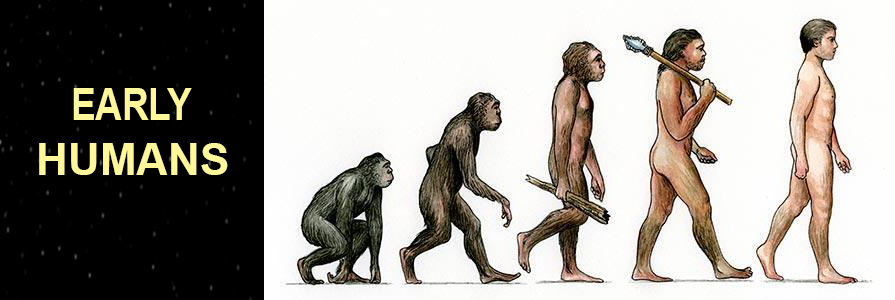
The Very Earliest Humanoid - Lucy

While hunting for fossils in the Afar Triangle in Ethiopia, in November 1974, paleo-anthropologist Donald Johanson and graduate student Tom Gray stumbled upon the partial remains of a previously unknown species of an ape-like hominid.
Nicknamed “Lucy,” the mysterious skeleton was eventually classified as a 3.2 million year old “Australopithecus afarensis” - one of humankind’s earliest ancestors. The headline grabbing find filled in crucial gaps in the human family tree. See an artists interpretation of Lucy to the left and see the map of AFAR, Ethiopia to the left below.
That night, the field team celebrated the discovery over dinner and several cans of beer. In the background, a stereo blared with the Beatles’ album “Sgt. Pepper’s Lonely Hearts Club Band”. When the song “Lucy in the Sky with Diamonds” came on, someone suggested calling the new skeleton “Lucy.” The name stuck.
When pieced together, the small bits of brown bone painted a stunning picture of what Lucy would have looked like. She was surprisingly small - slightly less than 4 feet tall and would have tipped the scales at roughly 60 pounds.
Her large pelvic opening suggested she was female, and wear on her wisdom teeth hinted she was probably around 20 years old when she died. She would have appeared more ape-like than human, with long arms and a protruding belly. Unlike knuckle dragging apes, however, the structure of her bones showed that she walked upright on two legs.
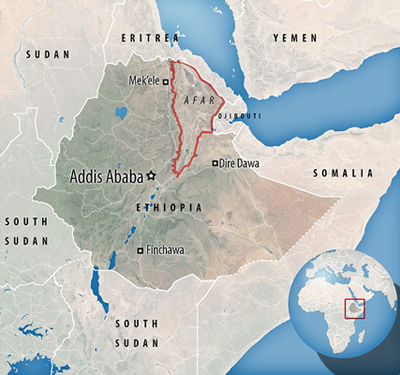
In this regard, Lucy was like nothing the researchers had ever seen before. Anthropologists had often speculated that erect posture had developed as hominids evolved larger brains. However, Lucy’s brain was only the size of a grapefruit - roughly as big as a chimpanzee’s. This suggested that upright walking had developed long before larger brains. "She had a tiny brain and yet walked erect", Johanson wrote in his 1981 book on Lucy. "Here was an ape-brained little creature with a pelvis and leg bones almost identical in function with those of modern humans.”
Once Lucy’s skeleton had been transported to the United States for further study, geologists used potassium-argon dating and other methods to fix the age of the basalt layer surrounding the discovery site at around 3.6 million years old. That number was later amended to 3.2 million years old using a more sophisticated dating process known as argon-argon dating.
Despite more recent breakthroughs, Lucy stands as perhaps the most famous hominid fossil discovery ever made. Casts of her skeleton sit in museums around the world, and hundreds of thousands of people flocked to a traveling exhibition of the original Lucy fossils in the 2000s.
In a 2009 interview with Time, Johanson speculated that Lucy’s enduring celebrity stemmed from the way she helped fill in the blanks in our understanding of early humans. “She showed us conclusively that upright walking and bipedalism preceded all of the other changes we’d normally consider being human”, he said. “She gave us a glimpse of what our older ancestors looked like.” Top
Lucy Was Not Alone
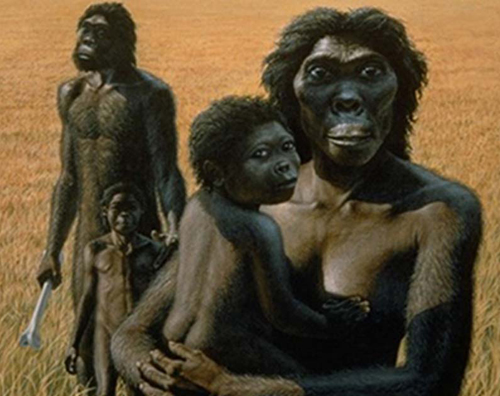
Scientists at the Max Planck Institute for Evolutionary Anthropology in Germany conducted a review of the years from 3.3 to 3.0 million years ago for hominin fossils found in Ethiopia, Kenya and Chad. The review concluded that four different species of human ancestors lived at that time.
The Four Separate Species Were:
-
Australopithecus afarensis was one of the longest-lived and best known early human species. The species, whose most famous fossil 'Lucy' came from Ethiopia, roamed the earth from about 3.9 to 2.9 million years ago.
-
The discovery of Australopithecus bahrelghazali from Chad in 1995 and Kenyanthropus platyops from Kenya in 2001 challenged the idea Australopithecus afarensis was alone.
-
The discovery of a 3.4 million-year-old Burtele partial foot announced in 2012 was the first conclusive
-
evidence that another early human ancestor species lived alongside Australopithecus afarensis.
-
The fourth species was identified as Australopithecus deyiremeda, a 3.5 to 3.3 million-year-old human ancestor species from Ethiopia, named in 2015.
The discovery of Australopithecus bahrelghazali in Chad in 1995 and Kenyanthropus platyops in Kenya in 2001 challenged the idea that Lucy was the only species. The two new species were not widely accepted, and were considered geographic variants of Lucy's species. The question now is "How were these species all related to each other and did they exploit available resources with each other?" Top
Details Of An Australopithecus Afarensis>
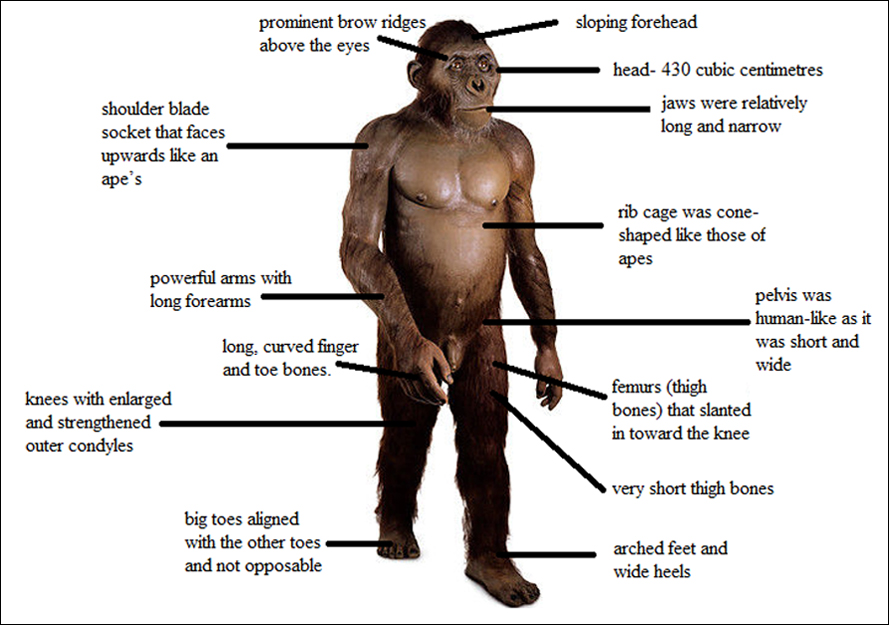
The Complex Evolution Of Humans
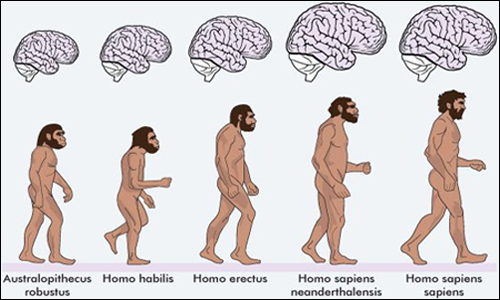
-
4 million years ago - Ape like early humans, the Australopithecus appeared. They had brains no larger than a chimpanzee's but other features were more like modern humans.
-
3.9-2.9 million years ago - Australopithecus afarensis lived in Africa, most likely in caves.
-
2.7 million years ago - Australopithecus robustus, lived in the woods and had massive jaws for chewing.
-
2.3 million years ago - Homo habilis were the first to show a significant increase in brain size and also the first to be associated with stone tools.
-
1.85 million years ago - First 'modern' hand emerges.
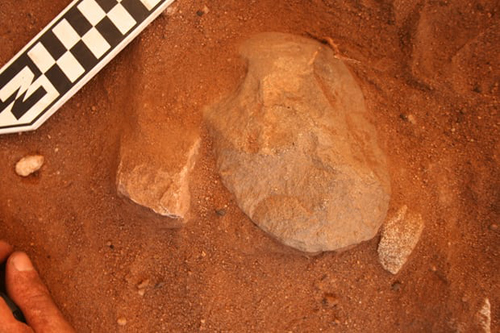
-
1.8 million years ago - Homo erectus is believed to have originated in Africa and and spread from there migrating throughout Eurasia. Homo erectus lasted a long time - until about 150,000 years ago
-
1.6 million years ago - Hand axes and other hand tools become the first major technological innovations. See a ground edge stone axe to the left. It is believed that they were invented by homo erectus.
-
800,000 years ago - Early humans control fire and create hearths. Credit is generally given to homo erectus. They also may have been the first to travel by water. Brain size was increasing rapidly.
-
400,000 years ago - Neanderthals (pronounced Neandertals) evolved in Europe (probably Germany) and were a separate breed from modern humans. They thrived and spread across Europe and Asia.
Neanderthals and modern humans share 99.7% of our DNA and hence we are closely related. Males were about 66 inches tall and females about 60 inches tall. Neanderthals went extinct about 40,000 years ago.
-
300,000 years ago - Homo sapiens - modern humans - appeared first in Africa. Recent discoveries put their origins about 300,000 years ago rather than 200,000 as previously thought. (See the next section below.) The ancestors of modern humans mated with Neanderthals hence the close DNA. Both Neanderthals and modern humans are believed to have evolved from Homo erectus.
-
40,000 years ago - Modern humans reach Europe. Like other early humans that were living at the time, they gathered and hunted food. They also evolved behaviors that helped them respond to the many challenges of survival.
The Recent Discovery at Jebel Irhoud in Morocco
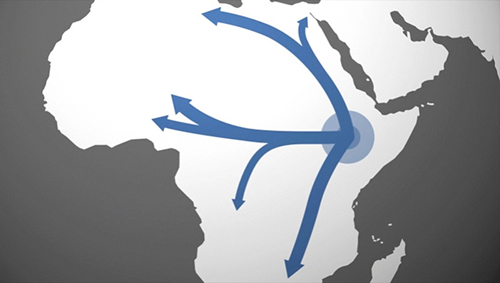
Until very recently (June, 2017) almost all anthropologists believed that modern humankind originated in and around the AFAR Triangle in Ethiopia, "eastern" Africa, about 200,000 years ago. They believed that all modern humans had descended from this Ethiopian population. See the illustration to the left.
The new find indicates that Homo sapiens are much older and had already spread across all of Africa about 300,000 years ago. This shows that the African story of our species evolution was much more complex than was previously believed.
In a cave called Jebel Irhoud, 62 miles west of Marrakech, Morocco on the "western" side of Africa, bones of its former occupants have been recently unearthed by an international team of scientists. See the map of Morocco to the left below. Jebel Irhoud marks the earliest fossilized remains of Homo sapiens ever found - about 300,000 years old. They supersede two Ethiopian fossils that are 160,000 and 195,000 years old. See the photo of the Jebel Irhoud cave - the second picture below.
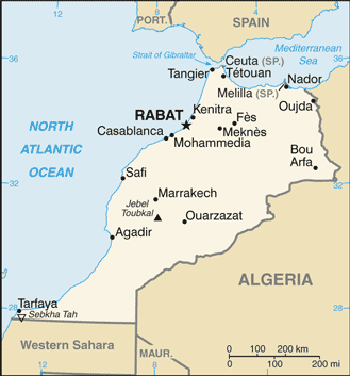
The fossil remains from Jebel Irhoud comprise skulls, teeth, and long bones of at least five individuals. To provide a precise chronology for these finds, researchers used the thermo-luminescence dating method on heated flints found in the same deposits.
These flints yielded an age of approximately 300 thousand years ago and pushed back the origins of our species by one hundred thousand years. The project which began back in 2004, has recently resulted in the discovery of new Homo sapiens fossils, increasing the number of human fossils found from 5 to 22.
"We used to think that there was a cradle of mankind 200 thousand years ago in east Africa, but our new data reveal that Homo sapiens spread across the entire African continent around 300 thousand years ago. Long before the out-of-Africa dispersal of Homo sapiens, there was dispersal within Africa," says palaeo-anthropologist Jean-Jacques Hublin.
"Well dated sites of this age are exceptionally rare in Africa, but we were fortunate that so many of the Jebel Irhoud flint artefacts had been heated in the past," says geochronology expert Daniel Richter of the Max Planck Institute for Evolutionary Anthropology in Leipzig, Germany.
Richter explains: "This allowed us to apply thermo-luminescence dating methods on the flint artefacts and establish a consistent chronology for the hominin fossils and the layers above them."
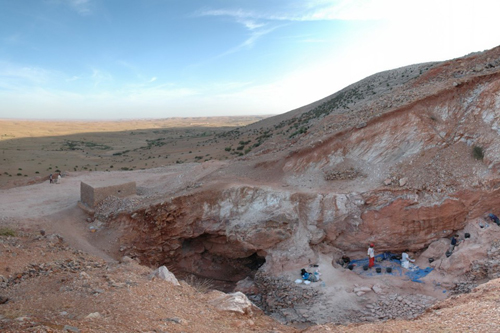
The crania of modern humans living today are characterized by a combination of features that distinguish us from our fossil ancestors - a small and gracile face and globular braincase. The fossils from Jebel Irhoud display a modern looking face and teeth, and a large but more archaic looking braincase. In contrast to their modern facial morphology, however, the Jebel Irhoud crania retain a rather elongated shape of the braincase.
"The inner shape of the braincase reflects the shape of the brain," explains Phillip Gunz of the Max Planck Institute. "Our findings suggest that modern human facial morphology was established early on in the history of our species, and that brain shape, and possibly brain function, evolved within the Homo sapiens lineage," says Gunz.
The earliest Homo sapiens fossils are found across the entire African continent: Jebel Irhoud, Morocco (300 thousand years), Florisbad, South Africa (260 thousand years), and Omo Kibish, Ethiopia (195 thousand years). This indicates a complex evolutionary history of our species, possibly involving the whole African continent. Top
Migration Out Of Africa

Homo sapiens began to move all over the continent of Africa about 300,000 years ago. The chart to the left is off in the sense that it shows East Africa as the original source. We now know (very recently) that all of Africa should be red.
Pioneering bands of humans managed to migrate away from their homelands into the Mid-East, where Homo sapiens remains have been uncovered at the site of the Skhul Cave in Israel. Homo sapiens remains from Skhul have been dated to between 90,000 and an almost unbelievable 130,000 years old. See the photo of the Skhul Cave to the left below.
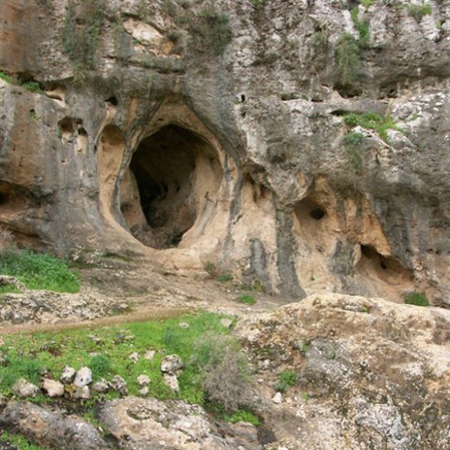
However, the initial human forays into the lands beyond Africa were dwarfed by a later migration. Around 55,000 years ago, what is now seen as the main wave (or waves) of modern humans was very successful. Much larger numbers than before spread out rapidly across India, China, Europe and the rest of the Old World. Homo sapiens met Neanderthals in some of these territories and interbred with them. They eventually ended up covering Australia, Russia, and finally the Americas.
All of this apparently happened at record speed. By 53,000 years ago, descendants of the main wave out of Africa reached the north of Australia, the south about 41,000 years ago. Reaching Australia was not straightforward though. Sea levels were about 100 meters lower than today. There was an inconvenient amount of water, a stretch of about 50 miles, standing between the early Homo sapiens in Asia and the landmass that included Australia, Tasmania, and New Guinea. These early humans probably built large rafts to help them make this gutsy crossing.
Meanwhile, a migration towards North East Asia began around 40,000 years ago paving the way to the Bering Land Bridge connecting North East Asia to the Americas. Humans are thought to have reached the Americas through this narrow connecting route about 15,000 years ago. It is thought that humans expanded downwards along the Canadian and US West Coasts. After the Americas, there were some last strongholds that remained human-free for a long time - such as Hawaii reached by boat about 100 AD, and New Zealand which held out until about 1000 AD.